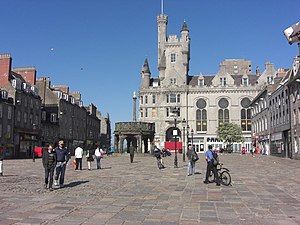Aberdeen Castle
| Aberdeen Castle | ||
|---|---|---|
|
Castlegate in Aberdeen, former location of the Aberdeen Castle. |
||
| Castle type : | Hill castle | |
| Conservation status: | no remains, destroyed around 1308 | |
| Geographical location | 57 ° 8 '57 " N , 2 ° 5' 25" W | |
|
|
||
Aberdeen Castle was a late medieval fortress in the Scottish city of Aberdeen . It stood on Castle Hill , a place now known as Castlegate (a paved square in the city center).
In 1308, the English-held castle is said to have been burned down by the Scottish King Robert I and the crew killed.
According to legend, the motto of the city of Aberdeen ( Bon Accord ) is said to be based on the watchword of the same name, which initiated the final destruction of the castle.
history
Aberdeen Castle was ceded to England in 1295 . After his victory over the Scots, Edward I traveled the Scottish east coast on April 14, 1296 and also came to Aberdeen, where he stayed in the castle for a time.
After the English were defeated at Dunnottar Castle the next year , William Wallace marched with his troops against Aberdeen. The aim was to recapture the east coast taken by England for Scotland.
Once there, they found the English hastily planning their departure. The escape should take place with around 100 ships. Surprised by Wallace's rapid arrival in Aberdeen, the ship's crew and soldiers were killed, the cargo confiscated and the ships stuck in the harbor due to the low tide burned to the ground.
The Englishman Sir Henry de Latham, who had been entrusted with the management of Aberdeen Castle, ran over to the Scottish side in the chaos of the battle and declared the Scottish King John de Balliol as the rightful owner of the castle.
It is believed that the castle was burned down by King Robert I in June 1308 during the Scottish Wars of Independence . Robert and his men first besieged the castle and then destroyed the English garrison to prevent it from being used by Edward II's troops .
The Scots killed every man they could get their hands on. They followed the example of Edward I , who had his prisoners executed.
On July 10, 1308, English ships left the port city of Hartlepool to unsuccessfully support the English garrison in Aberdeen. In August 1308, Aberdeen Castle's officer on duty, Gilbert Pecche, and his remaining troops were chased out of the city. After the destruction of Aberdeen Castle, Robert I marched with his troops against Forfar Castle with the aim of conquering it as well.
Individual evidence
- ↑ Aberdeen's Castle ( Memento from June 21, 2011 in the Internet Archive )
- ↑ Entry on Aberdeen Castle in Canmore, the database of Historic Environment Scotland (English)
- ^ Castlehill . The Doric Columns. Retrieved August 18, 2013.
- ↑ a b 1308: Seige of Aberdeen Castle . Bon Accord Metal Detecting and Historical Society. Retrieved August 18, 2013.
- ↑ Keith, Alexander: A Thousand Years of Aberdeen . Aberdeen University Press, Aberdeen 1987.
- ↑ Journal of the Movements of King Edward I in Scotland, 1296 ( Memento of February 6, 2012 in the Internet Archive )
- ↑ Andrew de Moray Unsung Hero of Scotland's Wars of Independence . Retrieved August 18, 2013.
- ^ Rebel Commander . Archived from the original on May 16, 2007. Retrieved August 18, 2013.
- ↑ Welcome to Aberdeen . destination-scotland.com. Archived from the original on May 4, 2007. Retrieved August 18, 2013.
- ^ A b George Lillie Craik and Charles MacFarlane : The Pictorial History of England: Being a History of the People, as Well as a History of the Kingdom . C. Knight & Co., 1841.
- ↑ Notable Dates in history ( Memento from May 26, 2013 in the Internet Archive )

